
Ingalls Shipbuilding is a shipyard located in Pascagoula, Mississippi, United States, originally established in 1938, and now part of HII. It is a leading producer of ships for the United States Navy, and, as of 2023, is the largest private employer in Mississippi.

The Maestrale class is a class of frigates of the Italian Navy. The class is composed of eight vessels, all of which were built by Fincantieri S.p.A., Riva Trigoso, except for Grecale, which was built by Fincantieri S.p.A. – Muggiano, La Spezia.

The Karel Doorman-class frigates are a series of eight multi-purpose vessels built for the Royal Netherlands Navy. Its namesake is Karel Doorman, a Dutch naval officer whose ship was struck by a Japanese torpedo in the Battle of the Java Sea in 1942, and went down with his ship as a result.
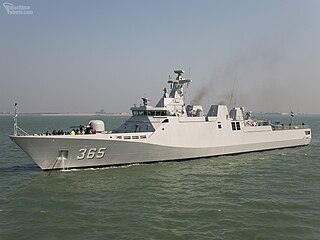
The SIGMA class is a Dutch-built family of modular naval vessels, of either corvette or frigate size, designed by Damen Group.
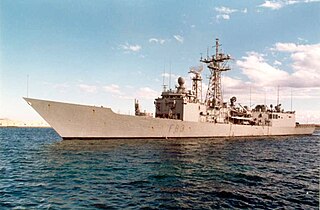
Numancia (F83) is the third of the six Spanish-built Santa Maria-class frigates of the Spanish Navy, based on the American Oliver Hazard Perry class design. The frigate was constructed in Spain by Bazan and laid down on 8 January 1986; launched on 29 January 1987; and entered service with the Spanish Navy on 17 November 1989. Based at Rota, Numancia has been deployed to the Indian Ocean to fight piracy in Somalia as part of Operation Atalanta and to the Mediterranean Sea to intercept illegal trafficking of migrants as part of Operation Sophia.

Canarias (F86), is the last of the six Spanish-built Santa María-class frigates of the Spanish Navy, which are based on the American Oliver Hazard Perry-class design. The Santa María class offer both anti-air and anti-submarine defence for the Spanish Navy. The frigate was laid down by Bazan on 15 April 1992 and launched on 21 June 1993. Upon entering service on 14 December 1994, Canarias was homeported at Rota and assigned to the 41st Escort Squadron. Canarias has been assigned to Operation Atalanta of the Somali coast, combatting piracy and Operation Sophia in the Mediterranean Sea, intercepting illegal trafficking of migrants.

Victoria (F82) is the second of the six Spanish-built Santa Maria-class frigates of the Spanish Navy, based on the American Oliver Hazard Perry class design. Constructed in 1983, the vessel was launched on 23 July 1986 and commissioned on 11 November 1987. The frigate has been assigned to Operation Atalanta, fighting piracy of the Somalian coast.
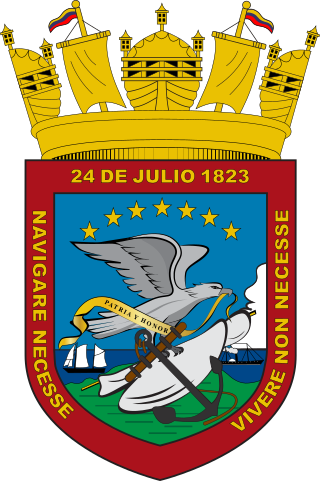
The Bolivarian Navy of Venezuela, commonly known as the Venezuelan Navy, is the naval branch of the National Bolivarian Armed Forces of Venezuela.

The Lupo class is a class of frigates built by Cantieri Navali Riuniti (CNR) for the Italian Navy. Designed as multipurpose warships with an emphasis on anti-surface warfare (ASuW), they have enjoyed some success in the export market, being acquired by the navies of Peru and Venezuela. A small run of a slightly updated version is known as the Soldati class.
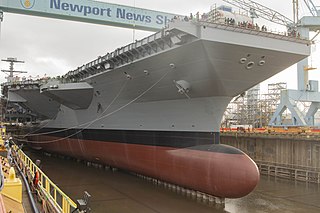
USS John F. Kennedy (CVN-79) is the second Gerald R. Ford-class aircraft carrier built for the United States Navy. She was launched on 29 October 2019, and christened on 7 December 2019.

The Almirante Brown class is a class of warships built for the Argentine Navy. They were commissioned between 1983 and 1984, after the Falklands War. The class comprised four ships; Almirante Brown, La Argentina, Heroína and Sarandí. Heronia was retired in 2024 after a period of prolonged inactivity.

The João Belo class, also known as Comandante João Belo class, is a class of four frigates of French design, based on the Commandant Rivière class but fitted for tropical service. Ordered by the Portuguese Navy in 1964, the four ships of this class were constructed at the shipyard in Nantes, France between 1965 and 1967. The first ship entered Portuguese service in 1967. The frigates were used for ocean patrol of Portuguese colonies and later, joined NATO's STANAVFORLANT unit. The first unit was discarded in 2003, followed by a second in 2004. The final two ships were taken out of service in 2008 sold to the Uruguayan Navy. The third ship was discarded in 2021, and the last ship was decommissioned on 12 August 2022.

ARA Sarandí is the fourth and last ship of the MEKO 360H2 series of destroyers built for the Argentine Navy. The ship is also the fourth ship in the Argentine Navy to bear that name. Sarandí is the name of a victory of the Argentine army during the Cisplatine War.

The EL/M-2238 3D-STAR is a multi-purpose air and surface-search naval radar system developed by IAI Elta for medium-sized ships like corvettes and frigates. STAR is an acronym of Surveillance & Threat Alert Radar.
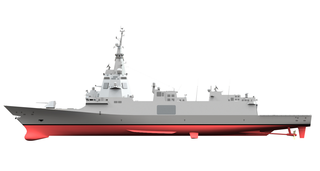
The F110 class, also known as the Bonifaz class, are a multi-purpose, anti-submarine class of Aegis combat system-fitted heavy frigates under construction for the Spanish Navy. The project is being co-developed by the Spanish Ministry of Defence and the state-owned company Navantia. The construction of the first unit (Bonifaz) started in April 2022. Deliveries are scheduled to start in about 2025.

ARV Almirante Brión (F-22) is the second ship of the Mariscal Sucre-class frigate of the Venezuelan Navy.

ARV General Urdaneta (F-23) was the third ship of the Mariscal Sucre-class frigate of the Venezuelan Navy.

ARV General Soublette (F-24) was the fourth ship of the Mariscal Sucre-class frigate of the Venezuelan Navy.

ARV General Salóm (F-25) was the fifth ship of the Mariscal Sucre-class frigate of the Venezuelan Navy.

ARV Almirante García (F-25) was the sixth ship of the Mariscal Sucre-class frigate of the Venezuelan Navy.
























